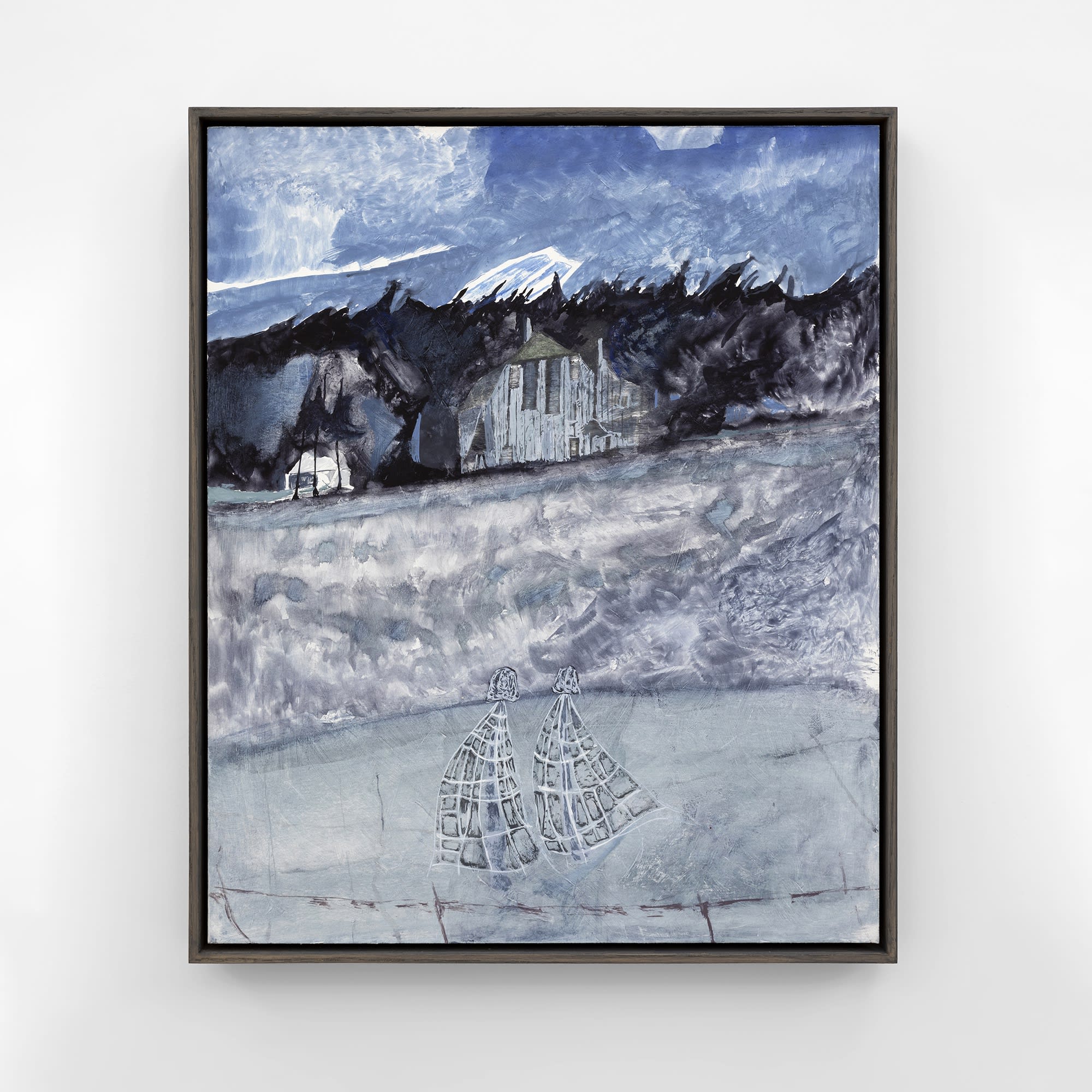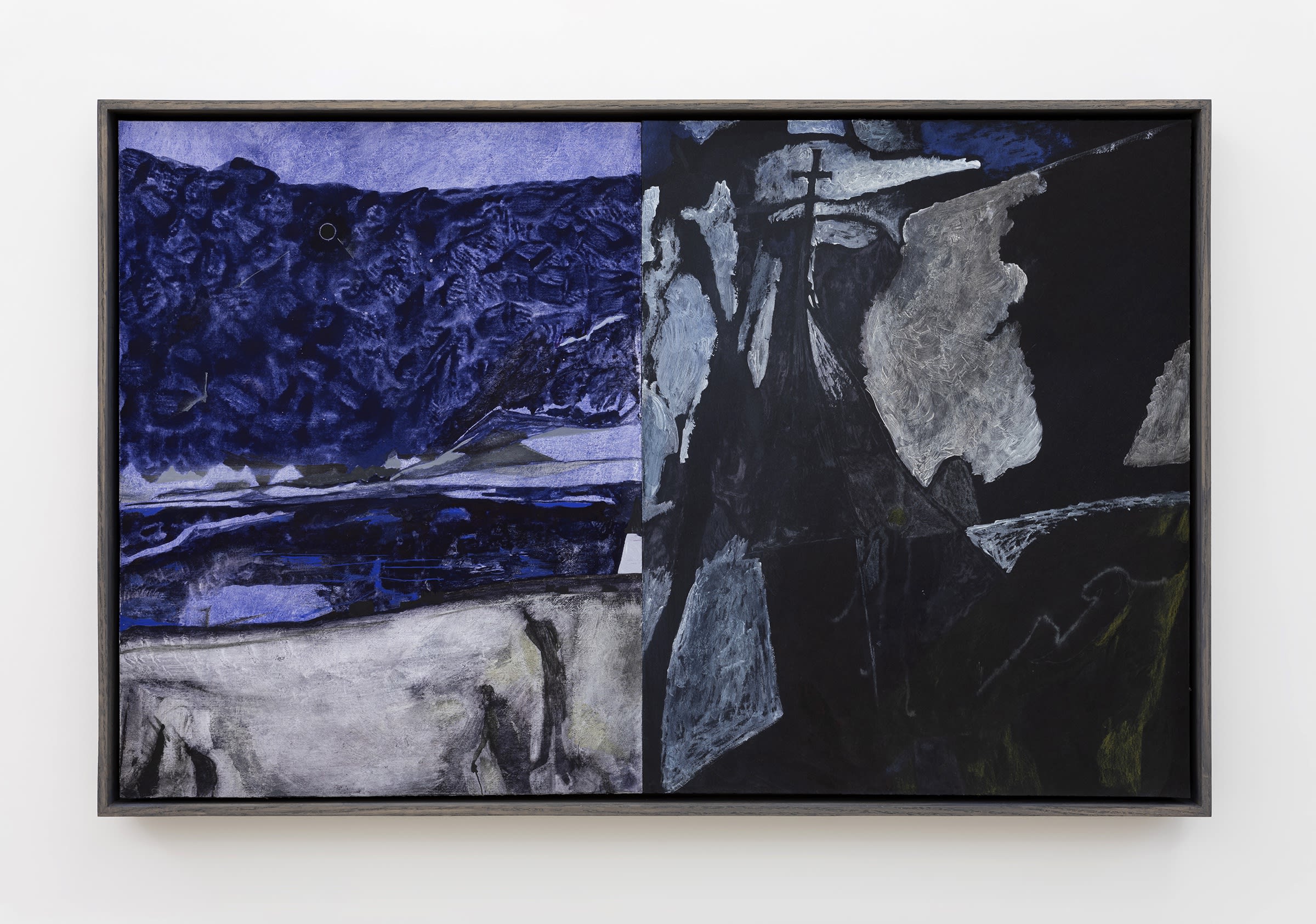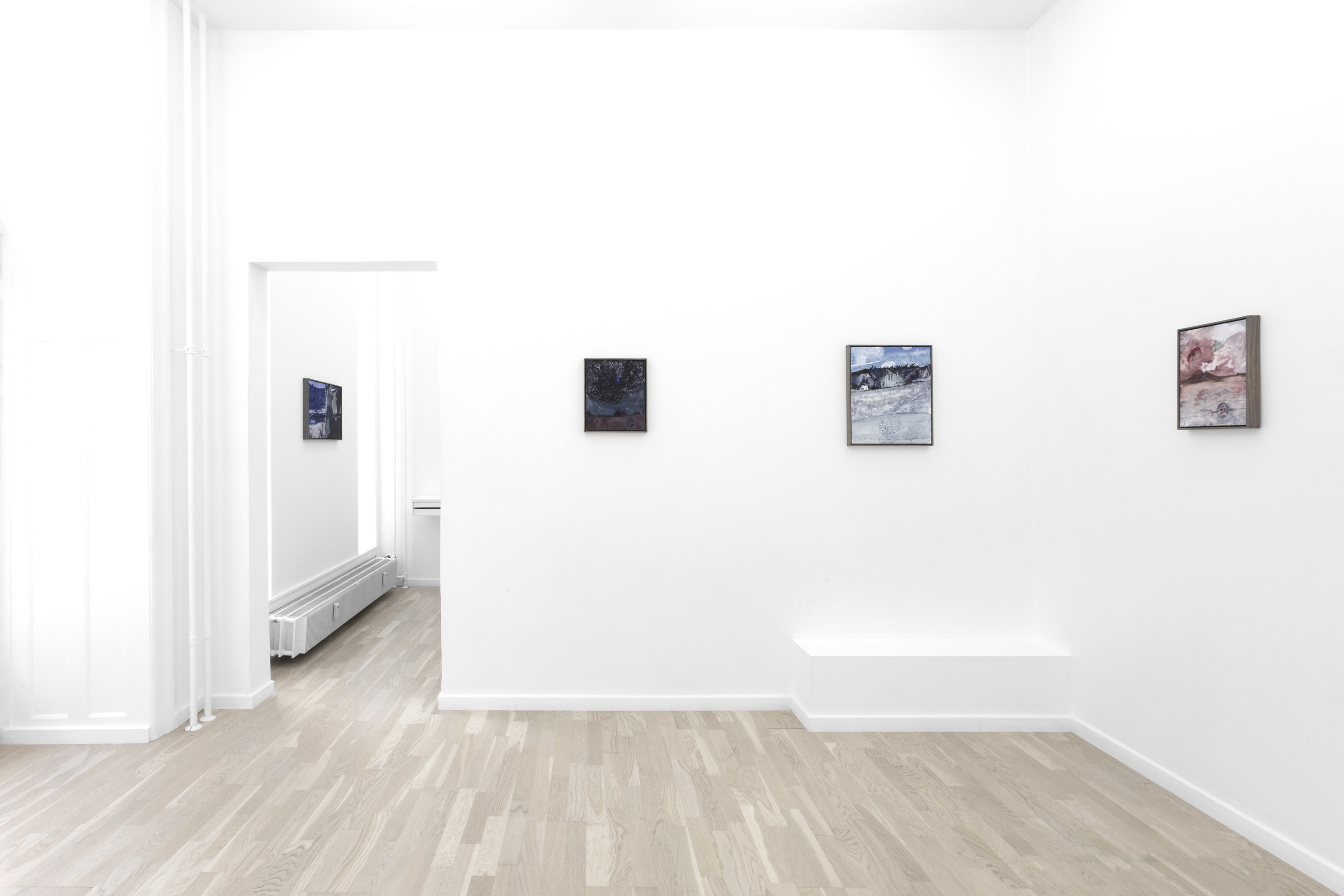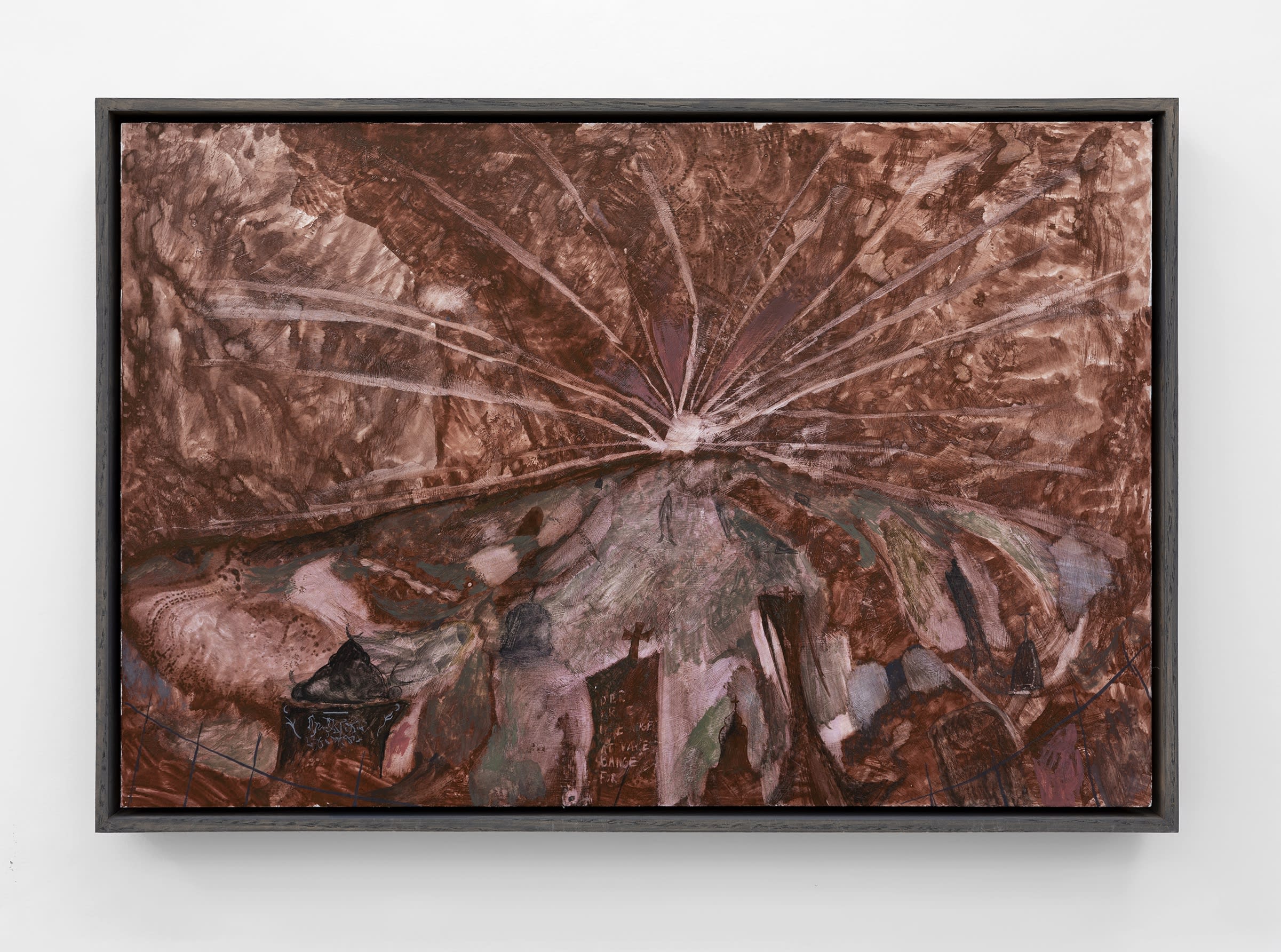 Clocks by Martin Aagaard Hansen. Courtesy of the artist and OTP Copenhagen.
Clocks by Martin Aagaard Hansen. Courtesy of the artist and OTP Copenhagen.
AW: Two O’Clock Spell presents a body of work on paper which you have created over the past year. Can you tell us a little about how they came to be, and how the process differs from your usual one?
MAH: The starting point of this body of work was basically when I visited this cliff in southern Denmark with two friends. It felt like ages ago since I had been in an open landscape like this, far away from anything. The way the trees stood, almost falling from the cliff, and how the whole scenery seemed to be pulled towards the edge. It was as if I suddenly understood something about landscape painting, which wasn’t really something I was planning on venturing into. But the longing for vastness, empty land and openness really hit me, and brought out so many ideas, early memories, and fantasies.
This was also a time where I often commuted between Oslo and Copenhagen by bus, so noticing and photographing situations in a scenery become a way to start the paintings when I couldn’t work on them directly. I feel like the whole series moves as if seen from a bus window or by train, something you aren’t really sure of because it happened too quickly.

Martin Aagaard Hansen, Out I Come, Wrong Season, 2024, gouache and tempera on paperboard, 46.5 x 38.5 cm / 18.3 x 15.2 inches [framed in stained oak]. Courtesy of the artist and OTP Copenhagen.
AW: You have established a painting practice known for balancing between abstraction and figuration, with a particular attention to experimenting with, on one hand, surfaces and texture, and on the other, the construction of depth and space. Using multiple layers of oil, pastel and gesso, you have elsewhere described this process with terminology akin to an archaeologist, namely: scraping, digging, and excavating. How did this approach translate (or not translate) when working with water-based gouache on paper and cardboard?
MAH: I think it’s important to mention that my use of figuration stems from a starting point of abstraction, I kinda started the opposite way around early on, I wanted to work purely abstract, but then recognizable shapes kinda burrowed their way into it and refused to leave. It felt very ambivalent since my curiosity, in a way, demanded them, but they would always feel strange and alien in the context of their surroundings.
The thing about "digging" has a lot to do with indecisiveness, and a constant urge to change all the time, so I started wiping and scraping off old compositions while simultaneously starting new ones on the surface. I had a feeling one day, that no ideas put into the work ever go to waste, they have, again "burrowed in". I wanted all the layers of time to play a role until the finished image, leaving small “keys” between the layers to use before the paintings set. Gouache lends itself perfectly to this method of painting since you can always change it with water and edit out things in the process.

Martin Aagaard Hansen, Seagull Squawk (Shoreline and Courtyard), 2024, gouache on paperboard, 39.5 x 61.5 cm / 15.6 x 24.2 inches [framed in stained oak]. Courtesy of the artist and OTP Copenhagen.
AW: You have a background in printmaking as well, is there a connection between your experience in printmaking and your approach for working on paper?
MAH: I studied printmaking in art school, and worked constantly in the workshop but I never actually felt like I succeeded in it. The thing I took from printmaking was probably that there is always a way to go deeper into the material, cutting or etching things away, I used a lot of scrap plates that already had other people’s old motifs on them to create my own. It felt like a palimpsest that’s been scraped off but still contained echoes of previous compositions.
I think that working on paper has always been important to me, although I have shown very little of it before now. I love the possibility of working anywhere with very few materials. There is something confined and intimate to smaller formats that I really enjoy, and I really look for that in other artists’ work too.

Martin Aagaard Hansen, Two O'Clock Spell, 2024, installation view. Courtesy of the artist and OTP Copenhagen.
AW: I am always fascinated by how your works materially evoke a sense of something ancient, worn or decaying even. It’s as if you purposely “overwork” surfaces until there is an oversaturation of manual marks. Could you elaborate on that?
MAH: So much of it is about searching for signs of human touch without them being there. I love those small signs of events that tell you so much about a situation that has played out before you arrived. It sometimes feels like you enter a party after everyone left, the energy still hangs thickly in the air. A painting is very much that, no matter the visual approach, I always see a certain desperate need to eternalise a surface with whatever the artist saw in that moment, in order to pass the moment on. For me that will always be enough. The “overworked” feeling of the surfaces underlines the time spent and the ideas that keep shifting, it’s like something that is desperate to find its form and settle for others to dissect.

Martin Aagaard Hansen, Bispebjerg Cemetery, 2024, gouache on paperboard, 45.2 x 31 cm / 17.8 x 12.2 inches [framed in stained oak]. Courtesy of the artist and OTP Copenhagen.
AW: There is a lose group of recurring figurative elements that pop up in your works; especially architecture, city scapes, roads, and various human-made structures that are juxtaposed with natural elements like insects and rural landscapes. Where do you find your motifs and what subject matters fascinate you right now?
MAH: Selective misplacement and a general feeling of absurdity. Cities as a motif interests me because of the fact that they almost don’t, they are a default setting, and something we constantly take for granted. I think there is so many poetic values in that oversight.
I remember being extremely hungover once, going to the corner store, and a giant mourning cloak butterfly flew right past me. That experience hit me so much, that a city is just a large arena of living things who inhabit it and then leave. It’s very banal but it still haunts and enlightens me.
I would love to have the ability to see everything that has ever played out anywhere I looked, like if there were transparent layers of everything that had ever moved through the local park for an example. How wild and vast it would feel to see that. Fragmented figures and their shifting surroundings in a giant abstracted mass. I think I look for that aspect wherever I can, traces of imprinted layers of time.
My palette carries those ideas too, I’m very attracted to colours which seems like they were once more vivid, it’s maybe sentimental but I like the feeling that the colours try so hard to be what they once were. When I think about my colours I always picture them belonging to a harbour: like sun-bleached and weatherbeaten harbour buildings and ships. [Cont.]

Martin Aagaard Hansen, Bispebjerg Cemetery, 2024, gouache on paperboard, 45.2 x 31 cm / 17.8 x 12.2 inches [framed in stained oak]. Courtesy of the artist and OTP Copenhagen.
The bright and more vivid colours that appear in the works are there to contest the sombreness, like in life in general, when moments of mundanity are interrupted by a sudden rush of brightness and clarity. These dichotomies can’t really exist without each other.
At the moment, I feel like I’m painting suburbs. Figures puttering about in open land, searching and being stuck in their paths. I think what ties this exhibition together is a focus on the more peripheral aspects of a painting which highlight the things that linger in corners, something approaching from afar, or even leaving the image.
I have so often sat and zoomed around in other artists’ works thinking “what if this distant section was the entire work?”. And somehow, I find that these works are an extension of that thought. They are their own outskirts of something barely visible.

Martin Aagaard Hansen, Two O'Clock Spell, 2024, installation view. Courtesy of the artist and OTP Copenhagen.
Martin Aagaard Hansen (b. 1988, Odense; DK) lives and works in Copenhagen, Denmark. He graduated from the MFA programme at the Royal Danish Academy of Fine Arts (Copenhagen; DK) in 2015 having received his BFA from the Royal Danish Academy of Fine Arts (Copenhagen; DK) in 2013.
Recent exhibitions include: The Eternal Village at Bibeau Krueger (New York; US); The Lurid Season at M+B (Los Angeles; US); Zeitgeist at Galleri Nicolai Wallner (Copenhagen; DK); and Autumn Skullcap at Union Pacific (London; UK).